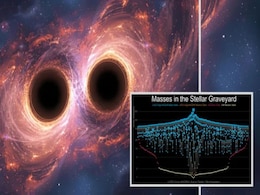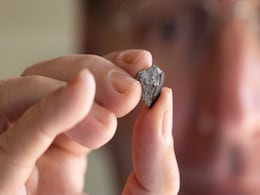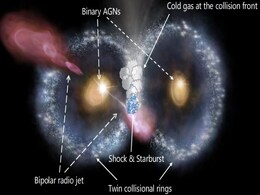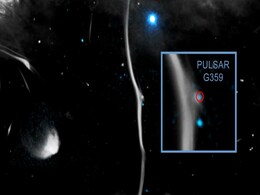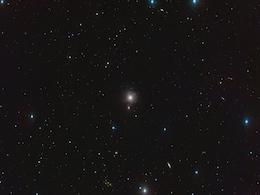Cosmic Collisions
- All
- News
-

NASA’s Chandra Spots Champagne Cluster Formed by a Massive Galaxy Collision
- Wednesday December 31, 2025
- Written by Gadgets 360 Staff
Discovered on New Year’s Eve 2020, the Champagne Cluster is a striking pair of colliding galaxy clusters revealed through combined X-ray and optical observations. NASA’s Chandra X-ray Observatory shows superheated gas stretched and distorted, exposing a massive cosmic collision hidden from visible light alone. Studied by UC Davis astronomers, t...
-
 www.gadgets360.com
www.gadgets360.com
-

NASA Spots Starquakes in a Red Giant Orbiting One of the Galaxy’s Quietest Black Holes
- Sunday December 28, 2025
- Written by Gadgets 360 Staff
A red giant star orbiting a quiet black hole spins faster than expected, while internal vibrations reveal it is younger than its ancient chemistry suggests. These findings hint at a past stellar merger and challenge existing models of star evolution in low-metal environments. Future observations aim to confirm its complex cosmic history.
-
 www.gadgets360.com
www.gadgets360.com
-

NASA Captures Asteroids Colliding Around Nearby Star Fomalhaut For The First Time
- Saturday December 20, 2025
- Science | Edited by Astitva Raj
The team will continue to monitor CS2 using Hubble for the next three years to observe its evolution.
-
 www.ndtv.com
www.ndtv.com
-

LIGO Detect Possible Second-Generation Black Holes with Extreme Spins
- Sunday November 2, 2025
- Written by Gadgets 360 Staff
LIGO-Virgo-KAGRA observatories detected two extraordinary black hole collisions in late 2024—GW241011 and GW241110. The first involved a rapidly spinning black hole, while the second revealed one rotating opposite its orbit. These findings fit predictions for second-generation black holes, born from earlier mergers within crowded star clusters. T...
-
 www.gadgets360.com
www.gadgets360.com
-

Astronomers Discover Stellar Graveyard Filled With Black Hole and Neutron Star Collisions
- Friday September 5, 2025
- Written by Gadgets 360 Staff
Astronomers using LIGO-Virgo-KAGRA detected 128 collisions of black holes and neutron stars, including two rare mixed mergers that double previous records. These findings reveal new details of stellar evolution, refine Hubble constant estimates, and test Einstein’s relativity in extreme conditions. The cosmic “graveyard” offers fresh insight ...
-
 www.gadgets360.com
www.gadgets360.com
-

Cosmic Visitor: 4.56-Billion-Year-Old Meteorite Strikes into Georgia Home
- Thursday August 14, 2025
- Written by Gadgets 360 Staff
On June 26, 2025, a dazzling daytime fireball streaked over Georgia, captured by satellites and witnessed across multiple states. A surviving fragment smashed through the roof of a McDonough home, denting the wooden floor 14 feet below. Scientists at the University of Georgia analyzed about 23 grams of this ancient rock, determining it to be a 4.56...
-
 www.gadgets360.com
www.gadgets360.com
-

James Webb Telescope Spots Rare ‘Cosmic Owl’ Formed by Colliding Galaxies
- Monday July 14, 2025
- Written by Gadgets 360 Staff
NASA’s James Webb Space Telescope has unveiled the “Cosmic Owl,” a jaw-dropping image of two colliding ring galaxies forming a structure that resembles an owl’s face. This double-ring formation is extraordinarily rare, and the event is shedding light on galaxy evolution, black hole dynamics, and rapid star formation. Led by Ph.D. student Mi...
-
 www.gadgets360.com
www.gadgets360.com
-

Most Distant Mini-Halo Discovered in Galaxy Cluster 10 Billion Light-Years Away
- Monday June 30, 2025
- Written by Gadgets 360 Staff
Astronomers have uncovered the most distant mini-halo ever detected, located around the galaxy cluster SpARCS1049, a staggering 10 billion light-years from Earth. Using the LOFAR radio telescope network, which spans eight European countries, researchers detected a faint, diffuse glow—evidence of a giant cloud of high-energy particles and magnetic...
-
 www.gadgets360.com
www.gadgets360.com
-

NASA Reveals a Fracture in Huge Cosmic Bone: Everything You Need to Know
- Monday May 12, 2025
- Written by Gadgets 360 Staff
With the use of the Chandra X-Ray Observatory, NASA has detected a fracture in the Milky Way. The bone is a galactic center filament that is based at a distance of 26,000 light years from Earth. The fracture would have occurred due to collisions with the neutron star, known as a pulsar, that spins rapidly. The scientists suspect that the fracture w...
-
 www.gadgets360.com
www.gadgets360.com
-

Supernova Remnants Found in Oceanic Samples, Scientists Look to Moon
- Wednesday March 26, 2025
- Written by Gadgets 360 Staff
Scientists have identified supernova debris in deep-sea sediments, including a rare plutonium isotope linked to a kilonova. Researchers believe a neutron star collision occurred nearly 10 million years ago, scattering radioactive material across space. To validate this theory, they plan to analyze lunar soil, which remains undisturbed by Earth's ge...
-
 www.gadgets360.com
www.gadgets360.com
-

Mysterious Planetary-Mass Objects May Form in Young Star System Clashes
- Wednesday March 12, 2025
- Written by Gadgets 360 Staff
Recent research challenges traditional views on planetary-mass objects, suggesting they may form through violent interactions between young star systems rather than standard planetary or stellar processes. Simulations indicate these clashes create dense gas filaments that evolve into free-floating objects, often in binary pairs. This discovery expl...
-
 www.gadgets360.com
www.gadgets360.com
-

Astronomers Spot Galaxy NGC 3640 With a Past of Consuming Smaller Galaxies
- Tuesday February 25, 2025
- Written by Gadgets 360 Staff
Recent observations of NGC 3640 reveal a history of merging with smaller galaxies. Located 88 million light-years away, the elliptical galaxy is suspected to be on a collision course with NGC 3641. The Very Large Telescope captured structural distortions, hinting at previous mergers. Researchers have identified ancient stars acting as fossil marker...
-
 www.gadgets360.com
www.gadgets360.com
-

Strange Fast Radio Bursts Emerge from an Ancient Dead Galaxy, Baffling Scientists
- Monday February 24, 2025
- Written by Gadgets 360 Staff
Scientists have detected mysterious fast radio bursts (FRBs) from the outskirts of an 11 billion-year-old dead galaxy. This discovery challenges the belief that FRBs primarily originate from young, star-forming galaxies. Researchers suspect the bursts may result from colliding stars or a collapsing white dwarf. The Canadian Hydrogen Intensity Mappi...
-
 www.gadgets360.com
www.gadgets360.com
-

Gravitational Waves Reveal Black Hole Ancestry Through Spin Analysis
- Monday February 3, 2025
- Written by Gadgets 360 Staff
A study published in Physical Review Letters explores how gravitational waves reveal the ancestry of black holes. By examining 69 black hole mergers, researchers found that spin shifts indicate repeated collisions in dense star clusters. This insight supports models suggesting black holes grow through sequential mergers. Observatories like LIGO and...
-
 www.gadgets360.com
www.gadgets360.com
-

NASA’s Chandra Spots Champagne Cluster Formed by a Massive Galaxy Collision
- Wednesday December 31, 2025
- Written by Gadgets 360 Staff
Discovered on New Year’s Eve 2020, the Champagne Cluster is a striking pair of colliding galaxy clusters revealed through combined X-ray and optical observations. NASA’s Chandra X-ray Observatory shows superheated gas stretched and distorted, exposing a massive cosmic collision hidden from visible light alone. Studied by UC Davis astronomers, t...
-
 www.gadgets360.com
www.gadgets360.com
-

NASA Spots Starquakes in a Red Giant Orbiting One of the Galaxy’s Quietest Black Holes
- Sunday December 28, 2025
- Written by Gadgets 360 Staff
A red giant star orbiting a quiet black hole spins faster than expected, while internal vibrations reveal it is younger than its ancient chemistry suggests. These findings hint at a past stellar merger and challenge existing models of star evolution in low-metal environments. Future observations aim to confirm its complex cosmic history.
-
 www.gadgets360.com
www.gadgets360.com
-

NASA Captures Asteroids Colliding Around Nearby Star Fomalhaut For The First Time
- Saturday December 20, 2025
- Science | Edited by Astitva Raj
The team will continue to monitor CS2 using Hubble for the next three years to observe its evolution.
-
 www.ndtv.com
www.ndtv.com
-

LIGO Detect Possible Second-Generation Black Holes with Extreme Spins
- Sunday November 2, 2025
- Written by Gadgets 360 Staff
LIGO-Virgo-KAGRA observatories detected two extraordinary black hole collisions in late 2024—GW241011 and GW241110. The first involved a rapidly spinning black hole, while the second revealed one rotating opposite its orbit. These findings fit predictions for second-generation black holes, born from earlier mergers within crowded star clusters. T...
-
 www.gadgets360.com
www.gadgets360.com
-

Astronomers Discover Stellar Graveyard Filled With Black Hole and Neutron Star Collisions
- Friday September 5, 2025
- Written by Gadgets 360 Staff
Astronomers using LIGO-Virgo-KAGRA detected 128 collisions of black holes and neutron stars, including two rare mixed mergers that double previous records. These findings reveal new details of stellar evolution, refine Hubble constant estimates, and test Einstein’s relativity in extreme conditions. The cosmic “graveyard” offers fresh insight ...
-
 www.gadgets360.com
www.gadgets360.com
-

Cosmic Visitor: 4.56-Billion-Year-Old Meteorite Strikes into Georgia Home
- Thursday August 14, 2025
- Written by Gadgets 360 Staff
On June 26, 2025, a dazzling daytime fireball streaked over Georgia, captured by satellites and witnessed across multiple states. A surviving fragment smashed through the roof of a McDonough home, denting the wooden floor 14 feet below. Scientists at the University of Georgia analyzed about 23 grams of this ancient rock, determining it to be a 4.56...
-
 www.gadgets360.com
www.gadgets360.com
-

James Webb Telescope Spots Rare ‘Cosmic Owl’ Formed by Colliding Galaxies
- Monday July 14, 2025
- Written by Gadgets 360 Staff
NASA’s James Webb Space Telescope has unveiled the “Cosmic Owl,” a jaw-dropping image of two colliding ring galaxies forming a structure that resembles an owl’s face. This double-ring formation is extraordinarily rare, and the event is shedding light on galaxy evolution, black hole dynamics, and rapid star formation. Led by Ph.D. student Mi...
-
 www.gadgets360.com
www.gadgets360.com
-

Most Distant Mini-Halo Discovered in Galaxy Cluster 10 Billion Light-Years Away
- Monday June 30, 2025
- Written by Gadgets 360 Staff
Astronomers have uncovered the most distant mini-halo ever detected, located around the galaxy cluster SpARCS1049, a staggering 10 billion light-years from Earth. Using the LOFAR radio telescope network, which spans eight European countries, researchers detected a faint, diffuse glow—evidence of a giant cloud of high-energy particles and magnetic...
-
 www.gadgets360.com
www.gadgets360.com
-

NASA Reveals a Fracture in Huge Cosmic Bone: Everything You Need to Know
- Monday May 12, 2025
- Written by Gadgets 360 Staff
With the use of the Chandra X-Ray Observatory, NASA has detected a fracture in the Milky Way. The bone is a galactic center filament that is based at a distance of 26,000 light years from Earth. The fracture would have occurred due to collisions with the neutron star, known as a pulsar, that spins rapidly. The scientists suspect that the fracture w...
-
 www.gadgets360.com
www.gadgets360.com
-

Supernova Remnants Found in Oceanic Samples, Scientists Look to Moon
- Wednesday March 26, 2025
- Written by Gadgets 360 Staff
Scientists have identified supernova debris in deep-sea sediments, including a rare plutonium isotope linked to a kilonova. Researchers believe a neutron star collision occurred nearly 10 million years ago, scattering radioactive material across space. To validate this theory, they plan to analyze lunar soil, which remains undisturbed by Earth's ge...
-
 www.gadgets360.com
www.gadgets360.com
-

Mysterious Planetary-Mass Objects May Form in Young Star System Clashes
- Wednesday March 12, 2025
- Written by Gadgets 360 Staff
Recent research challenges traditional views on planetary-mass objects, suggesting they may form through violent interactions between young star systems rather than standard planetary or stellar processes. Simulations indicate these clashes create dense gas filaments that evolve into free-floating objects, often in binary pairs. This discovery expl...
-
 www.gadgets360.com
www.gadgets360.com
-

Astronomers Spot Galaxy NGC 3640 With a Past of Consuming Smaller Galaxies
- Tuesday February 25, 2025
- Written by Gadgets 360 Staff
Recent observations of NGC 3640 reveal a history of merging with smaller galaxies. Located 88 million light-years away, the elliptical galaxy is suspected to be on a collision course with NGC 3641. The Very Large Telescope captured structural distortions, hinting at previous mergers. Researchers have identified ancient stars acting as fossil marker...
-
 www.gadgets360.com
www.gadgets360.com
-

Strange Fast Radio Bursts Emerge from an Ancient Dead Galaxy, Baffling Scientists
- Monday February 24, 2025
- Written by Gadgets 360 Staff
Scientists have detected mysterious fast radio bursts (FRBs) from the outskirts of an 11 billion-year-old dead galaxy. This discovery challenges the belief that FRBs primarily originate from young, star-forming galaxies. Researchers suspect the bursts may result from colliding stars or a collapsing white dwarf. The Canadian Hydrogen Intensity Mappi...
-
 www.gadgets360.com
www.gadgets360.com
-

Gravitational Waves Reveal Black Hole Ancestry Through Spin Analysis
- Monday February 3, 2025
- Written by Gadgets 360 Staff
A study published in Physical Review Letters explores how gravitational waves reveal the ancestry of black holes. By examining 69 black hole mergers, researchers found that spin shifts indicate repeated collisions in dense star clusters. This insight supports models suggesting black holes grow through sequential mergers. Observatories like LIGO and...
-
 www.gadgets360.com
www.gadgets360.com





